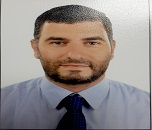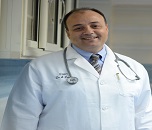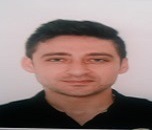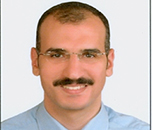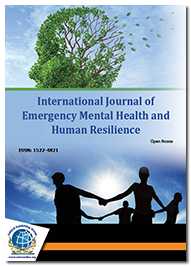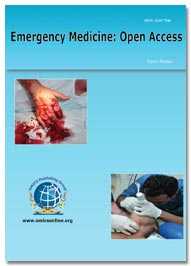Theme: “Understanding Complexities and Evolving towards a Better Direction in Emergency Medical Situationsâ€.
Trauma 2016
OMICS International takes immense pleasure & feels honoured in inviting the contributors across the globe to “Annual Congress and Medicare Expo on Trauma & Critical Care (Trauma & Critical Care-2016)” to be held during March 07-09, 2016 at Madrid, Spain. Trauma & Critical Care-2016 has been designed to address invites all the participants from all over the world which includes prompt keynote presentations, Oral talks, Poster presentations and Exhibitions.
Trauma & Critical Care 2016 is a global platform to discuss and learn about Elderly Trauma and Critical Care, Paediatric Trauma, Obstetric Trauma, Critical Care in Trauma, Psychological Trauma, Blunt Trauma, Intensive Care in Trauma, Evolution in Emergency Medicine Practices, New Technology in Trauma Care, Trauma Emergency Medicine , Biological need of Trauma, Trauma-An International Perspective, Trauma-Mass Causalities Incident, Trauma Therapy and Trauma in Nursing and Midwifery.
Track 1: Elderly Trauma and Critical Care
Most researchers have found that trauma patients older than 65 have a higher rate of mortality, longer hospital stays, more complications, common mechanism of injuries, and poorer outcomes than their younger counterparts. Patients on warfarin are considered at increased risk for traumatic intracranial hemorrhage .An intracranial hemorrhage (ICH) is a hemorrhage, or bleeding, within the skull. Many developmental changes in the Trauma events that occur in older adulthood constitute stressors which includes diminished sensory capacities, decreased mobility, physical frailty, income shrinkage and financial limitations, loss of friends, social status, isolation, changes in housing, multiple medications, complex medical problems, ill health, retirement, widowhood, cognitive impairment or loss, and impaired self-care.
The estimates of traumatic exposure and vary Post Traumatic Stress Disorders and Treatment depending on the traumas and symptoms assessed and samples surveyed, in a community of Emergency Medicine conferences sample. Cardiovascular emergency medicine is a life-threatening disorders that must be recognized immediately to avoid delay in treatment and to minimize morbidity and mortality .The systems approach to trauma through Critical Care meetings, and cardiac and stroke events is a comprehensive approach that provides injury and illness prevention, Emergency medical services (EMS) care, hospital emergency department care. Age was a consequential prognostic factor in multiple trauma patients who require neurosurgical operations. Neurological Emergency Care deals with the nervous system of life-threatening diseases, which involve the brain, spinal cord and nerves. Cardiogenic causes of pulmonary edema results from high pressure in the blood vessels of the lung due to poor heart function. It leads to impaired gas exchange and may cause respiratory failure.
From 2013 to 2019, the global market for mechanical ventilators is likely to register a CAGR of 6.6%. The market was worth US$2,715.7 million in 2012 and is therefore estimated to reach an overall value of US$4,248.7 million in 2019.Transparency Market Research has released a research report titled Mechanical Ventilators Market - Global Industry Analysis, Size, Share, Growth, Trends and Forecast, 2013 - 2019.The report’s purpose is to distinguish between the numerous growth drivers and restraints of this market, along with historic and forecast data to provide a complete statistical view.
Recommended Trauma Conferences | Acute Care Meetings | Critical Care Events | ConferenceSeries Ltd
International Conference on Intensive and Critical Care Nursing, November 21-23 2016 Dubai, UAE; 8th Global Cardiologists Annual Meeting July 18-20 2016 Berlin, Germany; 5th World Congress on Neurology and Therapeutics March 14-16, 2016 London, UK; ESTD Conference, April 14-16,2016, Amsterdam; Trauma Conference April 23-24th 2016, Singapore; 17th Annual CIS, August 18-21 2016, Chicago; Neurorehabilitation Summit: Regeneration, Recovery, Reintegration CME April 11-12, 2016 Rochester, United States; 9th WCNR May 10-13, 2016 Philadelphia, United States.
Track 2: Paediatric Trauma
The field has made major advances in the areas of lung injury, sepsis, traumatic brain injury, and postoperative care. The paediatric intensives role in the Trauma Events is to provide supportive care during cardiorespiratory or multi-organ failure or recovery from surgical interventions or trauma that refers to a traumatic injury that happens to an infant, child or adolescent. It deals with the medical care of infants, children, and adolescents, and the age limit usually ranges from birth up to 18 years of age. It is an area within a hospital specializing in the care of critically ill infants, children. The risk of death for injured children is significantly lower when care is provided in paediatric trauma centres rather than in non-paediatric trauma which are included in the Critical Care meetings.
The initial assessment is critical in determining the extent of injuries and what will be needed to manage an injury, and treating immediate life threats. The Adolescent care focuses on care of patients who are in the adolescent period of development, generally ranging from the last years of elementary school until graduation from high school. Issues with a high prevalence during adolescence are frequently addressed by providers at the Trauma Meetings. These include: Sexually transmitted disease unintended pregnancy, Birth control, abuse, menstrual disorders, acne eating disorders.
The Society of Critical Care Medicine (SCCM) represents proximately 16,000 highly trained professionals in more than 100 countries who provide care in specialized units and work toward the best outcome possible for all critically ill and injured patients. Between 2000 and 2005, annual critical care medicine costs incremented from $56.6 to $81.7 billion, representing 13.4% of hospital costs, 4.1% of national health expenditures, and 0.66% of gross domestic product. Cost savings up to $1 billion per quality-adjusted life year can be procured with critical care management of rigorous sepsis, acute respiratory failure, and general critical care interventions. Up to $13 million in annual hospital cost savings can be realized when care is distributed by an intensivist-directed multiprofessional team. More than 5 million patients are admitted annually to ICUs in the Coalesced States, dramatic elevate in patients 85 years and older, from 4.1% in 1991 to 6.9% in 2004. Between 2000 and 2020, the population younger than 65 years is expected to grow by about 10%, while the number of individuals 65 years and older is projected to elevate by approximately 50%. In 2000, children and adolescents accounted for 6.3 million hospital stays (18%)
Recommended Trauma Conferences | Acute Care Meetings | Critical Care Events | ConferenceSeries Ltd
4th International Conference on Paediatrics March 29-31 2016 Atlanta, USA; 2nd International Conference and Exhibition on Pediatric Cardiology September 22-24 2016, Las Vegas USA; International Conference on Pediatric Dermatology October 10-12 2016, Manchester UK; International Conference on Paediatric Nursing and Healthcare July 11-13, 2016 Cologne, Germany; Atlanta, 5th International Conference on Family Nursing June 13-15 2016, Philadelphia USA; 4th Annual Pediatric Critical Care Self-Assessment, April 14-17 2016, United States; 10th International Meeting of Pediatric Endocrinology, September 14-17 2017, United States.
Track 3: Obstetric Trauma
Medical specialty dealing with the care of all women's reproductive tracts and their children during pregnancy (prenatal period), childbirth and the postnatal period is Obstetric care. It involves a complex multi-disciplinary approach, yet despite huge advances in Emergency Medicine Conferences in cardiology over the last few decades, maternal death from cardiac causes continues to rise, determinants of glucocorticoid dosing, diabetics and diagnosis of adrenal insufficiency in adults are the factors of endocrine metabolism. A reversible condition where in large vacuoles of triglyceride fat accumulate in cells via the process of steatosis is a cause of liver disease. Severe acute arterial hypertension can be associated with significant morbidity and mortality, although most commonly related to inadequate pain control.
Large scale studies of intensive care unit-acquired infections in developing countries infection control strategies to reduce these infections are essential in various Trauma events. Hand hygiene is the most important component reducing the spread of infections. Illnesses, disorders, and injuries that involved in the nervous system frequently require a neurologist’s treatment that deals with the diagnosis of all categories of conditions and disease involving the central and peripheral nervous system known as Neurology including their coverings, blood vessels, and all effector tissue, such as muscle. Substance which when taken into a body by one mean or another produces a condition of diminished mental and physical ability, hyper excitability, or stupefaction in which Gastrointestinal decontamination, general approach to drug poisoning adults and management of moderate and severe alcohol withdrawal syndromes includes in intoxicants.
Recommended Trauma Conferences | Acute Care Meetings | Critical Care Events | ConferenceSeries Ltd
Pregnancy Summit and Child Health August 29-31, 2016 Sao Paulo, Brazil; 2nd International Conference on Gynecology and Obstetrics November 16-18, 2015, San Antonio USA; 6th Global Healthcare and Fitness Summit August 22-24 2016 Philadelphia USA; 7th Health Care and Fitness Summit September 26-28 2016, London UK; 72nd Annual Clinical Meeting of SOGC, June 14-17th 2016, Canada; 4th International congress on Cardiac Problems in Pregnancy, Feb 27-March 01 2016, Las Vegas; AAN Annual Meeting April 15-21 2016, Vancouver Canada; 51st International Liver Conference, April 13-13 2016, Barcelona Spain.
Track 4: Critical Care in Trauma
The critical care approach focuses on the level of care that individual patients need at various points in their clinical course towards the Critical Care meetings, rather than on beds and buildings. Clinical decision rules are now widely recognised as best practice for an increasingly common presence in the biomedical literature and represent one strategy of enhancing and making with the goal of improving the efficiency and effectiveness of healthcare delivery like Trauma Events. Diabetes is a medical condition in which there is little or no insulin production in the pancreas. Some of the rules which are concerned for the conscious and unconscious situations are: If the patient is unconscious,support the patient on their side and call for an ambulance and give the patient some sugar, still fully conscious and able to swallow, give a sweetened drink, chocolate or glucose sweets to suck – an improvement usually occurs within minutes.
Emergency physicians often encounter patients suffering from burn injuries. Most are minor in nature but approximately 100,000 a year are true emergencies. The treatment of minor burns focuses on three primary objectives: relief of pain, prevention of infection and additional trauma, and minimizing of scarring and contracture. Airway injuries, trauma other than the burn injury, treatment of shock, and pain relief are of the highest priority, overriding the management of the burn wound itself.
The International Sodality for the Surgery of Trauma and Surgical Intensive Care was founded in 1988. It is an integrated society within the broader International Society of Surgery-Société Internationale de Chirurgie, which was founded in 1902, has over 3000 members in 80 countries, and is compromised of members at immensely colossal and those in 4 integrated and 14 participating societies. Injury accounts for 16% of the ecumenical encumbrance of disease. The encumbrance of death and incapacitation from injury is especially eminent in low- and middle-income countries. By far the greatest part of the total encumbrance of injury, approximately 90%, occurs in such countries. Critical Care Market 2019 Magnification from Factor Concentrates Incipient Designations and Incrementing Demand for Albumin in Asia-Pacific. Ecumenical critical care market is still an untapped market, with a minuscule number of players accounting for major proportion. The market grew at a very slow magnification rate between 2006 and 2012, possibly due to the lack of availability of many of the products in certain markets, especially in the US. Overall critical care therapeutics market was worth $2.3 billion in 2012, having grown in size at a CAGR of 11% from $1.2 billion in 2006. The market is expected to grow at a CAGR of 5% to reach $3.2 billion in 2019. The double-digit market magnification registered between 2006 and 2012 can be attributed primarily to the incremented demand for and cost of albumin, as well as the approbation and launch of incipient products.
Recommended Trauma Conferences | Acute Care Meetings | Critical Care Events | ConferenceSeries Ltd
International Conference on Intensive and Critical Care Nursing November 21-23, 2016 Dubai, UAE; 58th Annual Scientific Meeting of the American Headache Society, June 23-26 2016, California United States; 18th Annual Conference of the International Society for Bipolar Disorders, July 13-16 2016, Amsterdam Netherlands; 45th Critical Care ,Congress February 20-24, 2016 Florida, USA; 47th CSHP, Jan 30-Feb 3 2016, Canada; Primary Care ,Today May 1 2016, Canada.
Track 5: Psychological Trauma
The term complex trauma describes both children’s exposure to multiple Traumatic events, often of an invasive, interpersonal nature, and the wide-ranging, long-term impact of this exposure. Since they often occur in the context of the child’s relationship with a care giver, they interfere with the child’s ability to form a secure attachment bond. Early childhood trauma generally refers to the traumatic experiences that occur to children aged 0-6. Because infants and young children's reactions may be different from older children, and they may not be able to verbalize their reactions to threatening or dangerous events.When young children experience or witness a traumatic event, sometimes it is called, Sexual abuse, also referred to as molestation, is a forcing undesired sexual behavior by one person upon another. However, young children are affected by traumatic events, even though they may not understand. Alternative terms sometimes used include physical assault or physical violence, and may also sexual abuse. other type of abuse is Physical abuse which is an act of a person involving contact of another person intended to cause feelings of physical pain, injury.Refugee war trauma is from conflict zones which often continue to experience trauma from persecution, imprisonment, torture and resettlement for a long time. Thus, it is important to understand the challenges of refugee families and communities. In relationships and domestic situations, people use emotional, psychological and physical abuse to gain control over their partners and children.
Biomarkers provide a dynamic and powerful approach in the Critical Care Conferences to understanding the spectrum of neurological disease with applications in observational and analytic epidemiology. Some categories of psychoactive drugs, which are prescription medicines, have medical therapeutic utility, such as anesthetics, analgesics, hormonal preparations, and some stimulant medications and some sleep disorders. Terrorism is commonly defined as violent acts intended to create fear, perpetrated for an economic, religious, political, or ideological goal, and which deliberately target or disregard the safety of non-combatants in the Emergency Medicine Conferences.
In 2009, the record exhibit for Psychology ARTICLES on the Psychology platform underwent a full redesign to better accommodate our users Institutions with electronic access to American Psychological Sodality Journals through PsycARTICLES, have incremented by 50% over the last 5 years. Numbers of institutions were 2939. Critical care units are the most expensive sites in the U.S. healthcare system, accounting for 30% to 40% of an acute care hospital's total budget. Despite the costs involved, critical care is one of the most expeditious-growing specialties in healthcare, for critical care patient monitoring products that was valued at proximately $1.2 billion in 2002. Growing at a compound annual rate of 8.9%, sales of these products are expected to reach an estimated $2.8 billion in the year 2012 and gradually the percentage will be increased in 2018.
Recommended Trauma Conferences | Acute Care Meetings | Critical Care Events | ConferenceSeries Ltd
2nd Psychiatry Conference May 02-04 2016 Chicago USA; 2nd International conference on Emergency Mental Health and Human Resilience July 14-15 2016 Cologne Germany; International Conference on Cognitive Behavioural Therapy , June 13-15 2016 Philadelphia USA; 3rd Euro Psychiatrists Meeting on Psychiatry September 07-09 2016, Amsterdam The Netherlands; International Conference on Psychosomatic Medicine October 17-19 2016 Rome, Italy; 2nd International Conference on Psychiatry and Psychiatric Disorders May 02-04 2016, Chicago USA; Psychiatry in Medical Settings, January 21-23 2016, United States; Psychiatry Update 2016, March 10-12 2016 Chicago, United States; 58th Annual Scientific Meeting of the American Headache Society, June 23-26 2016, California United States; 18th Annual Conference of the International Society for Bipolar Disorders, July 13-16 2016, Amsterdam Netherlands; 8th ICP - 4th ISCAP, April 20-24 2016, Antalya Turkey.
Track 6: Blunt Trauma
Blunt trauma is a physical trauma to a body part, either by impact, physical attack or injury. It is contrasted with penetrating trauma, in which an object such as a bullet enters the body. It is having variations like abdominal, kidney and splenetic trauma. The abdominal trauma comprises 75% of all blunt trauma and is the most common example of this injury. When blunt abdominal trauma is complicated by 'internal injury', the liver and spleen are most frequently involved, followed by the small. Splentic trauma occurs when a significant impact to the spleen from some outside source (i.e. automobile accident) damages or ruptures the spleen.
Treatment varies depending on severity, but often consists of embolism or splenectomy. In all the three abnominal, splentic and kidney trauma majority occurs in automobile accident victims, in which it is a leading cause of internal bleeding but the consequences are usually less severe than injuries involving other internal organs for the kidney trauma. So for personal protection, a equipment is necessary to protect ourselves from injuries caused by blunt impacts. Blunt trauma generally involves a balance between protection and function. During emergency response operations, to prevent heat stress, to perform necessary roles, tasks and actions, to maintain impact protection and coverage areas, wearing PPE (personal protective equipment) is necessary.
Track 7: Intensive Care in Trauma
The intensive care unit care of the trauma patient differs from that of other intensive care unit patients in many ways, one of the most important is the need to continuously integrating in the Critical Care meetings is operative and non-operative therapy. Both invasive and non-invasive mechanical ventilation techniques are inherent to the care of most patients admitted to intensive care units. Artificial mechanical ventilation has substantially improved outcomes of children suffering respiratory failure, by maintaining adequate oxygenation and ventilation until the underlying pathologic process resolves. Simulation technique is used for the practice and learning that can be applied to many different disciplines and trainees at Trauma events. In emergency medicine simulation, it provides a valuable tool in learning to mitigate ethical tensions and resolve practical dilemmas. Endocrine and diabetics provides a global, authoritative, and independent forum for high impact clinical research and opinion covering all aspects of endocrinology, diabetes,obesity, osteoporosis, bone metabolism, as well as thyroid and lipid.
Ultrasonic devices are used to detect objects and measure distances. Ultrasonic imaging (sonography) is used in both veterinary and human medicine. In the non-destructive testing of products and structures, ultrasound is used to detect invisible flaws. A variety of imaging techniques such as X ray radiography, ultrasound, computed tomography, medicine including positron emission tomography (PET), and magnetic resonance imaging (MRI) to diagnose and/or treat diseases.Ultrasonography can detect pleural, pericardial and abdominal fluid, and is able to visualize ruptured parenchymal organs in which radiology imaging is used to diagnose and treat disease seen within the body.
Critical care units are the most expensive sites in the U.S. healthcare system, accounting for 30% to 40% of an acute care hospital's total budget. Despite the costs involved, critical care is one of the most expeditious-growing specialties in healthcare, for critical care patient monitoring products that was valued at proximately $1.2 billion in 2002. Growing at a compound annual rate of 8.9%, sales of these products are expected to reach an estimated $2.8 billion in the year 2012. The amalgamated U.S. market for critical care patient management products is projected to increment from $3.9 billion in 2013 to $4.9 billion in the year 2018. Drug and fluid distribution products account for 59%, POC blood testing products account for 23%, and airway management/ventilation products account for the remaining 18%.
Recommended Trauma Conferences | Acute Care Meetings | Critical Care Events | ConferenceSeries Ltd
International Conference on Intensive and Critical Care Nursing November 21-23, 2016 Dubai, UAE; 36th International Symposium on Intensive Care and Emergency Medicine 15-18 March 2016 Belgium; 29th European Society of Intensive Care Medicine (ESICM) Annual Congress, October 01-05 2016, Lombardia; SCCM Annual Congress, January 20-24, 2016 USA; ICEM 2016, April 18-21 2016, Cape Town; ACEM Annual Scientific Meeting November 20-24, 2016 New Zealand.
Track 8: Evolution in Emergency Medicine Practices
The practice of emergency medicine is an essential link in the care of the acutely ill or injured patients. The emergency medicine conferernces specialty is therefore a formal institution with standards of practice and training in which is a form of practice accepted by the lay-public as a medical resource specifically for medical emergencies; a practice and system of care in which the medical profession possess special knowledge regarding medical emergencies and actively participates in the care of medical emergencies at Trauma meetings.The evolutionary origins of traumatic insemination are disputed.Trauma itself seems to be an astonishing shape-shifter of a diagnosis, which is likely to see in any client’s anxiety, fear, mood swings, guilt and shame, sadness and depression, dissociation, irritability and anger, difficulty concentrating, chronic fatigue, bodily aches, substance abuse, eating disorders, relationship difficulties etc.
About one hundred years ago the world witnessed casualty numbers of epics proportions during the Great War.Major Divisions include tobacco control, cancer screening services, obesity prevention, cancer registry, diabetes prevention and control. Different levels of clinical policy of Critical Care meetings include Level A recommendations represent patient management principles that reflect a high degree of clinical certainty. Level B represents patient management principles that reflect moderate clinical certainty. Level C represents other patient management strategies based on Class III studies. Prevention includes a wide range of activities known as interventions aimed at reducing the risks to health, such are Primary, Secondary and Tertiary prevention in which they together map out the range of interventions that are available to health experts. Emergency medical services provide immediate care to people with acute illness or injury, and are predominantly provided.
Asia is expected to overtake Europe in pharmaceutical sales, driven by magnification in key emerging markets. For example, China is prognosticated to be the second most immensely colossal pharmaceutical market after the Cumulated States by 2015. 85% of the world's population lives in the emerging markets, and during the past 5 years, all authentic economic magnification has emanate from these markets. The ecumenical market for ambulance and emergency medical accommodations (EMS) equipment in 2012 was $5.8 billion and reached $5.9 billion in 2013. At a 2.9% compound annual magnification rate (CAGR) from 2013 to 2018, this market is expected to elevate to $6.8 billion in 2018.
Recommended Trauma Conferences | Acute Care Meetings | Critical Care Events | ConferenceSeries Ltd
3rd International Conference and Exhibition on Physical Medicine and Rehabilitation August 25-27 2016, Philadelphia USA; 4th International Conference on Tissue Science and Regenerative Medicine September 12-14 2016 Berlin, Germany; International Conference on Pain Medicine May 16-18, 2016 San Antonio, USA; Annual Paediatric Emergency Medicine Conference March 29-31, 2016 Atlanta USA; 2016 Critical Procedures in Emergency Medicine, September 12 2016, Maryland United States; X-Ray - Emergency Interpretation, March 6 2016, Australia; X-Ray - Emergency Interpretation, March 13 2016, Camper down, Australia; Ski Best Evidence in Emergency Medicine, February 1-3 2016, Canada; 34th Annual Emergencies in Medicine Conference, March 6-10 2016, Utah United States.
Track 9: New Technology in Trauma Care
Technological advances in diagnostic tests that are found in hospitals are now poised to appear in primary care. Many of these advances have occurred because of the speed, size and range of devices in different Trauma events that can provide accurate measurements of a wide range of biochemical, microbiological, and haematological parameters. Glucometers transformed the speed and ease of obtaining accurate blood glucose levels, and urine dipsticks removed the need for microscopy in many patients. Advances in electronics have also made in-roads into general practice, with cheap and generally accurate blood pressure devices now widely available both in the practice and at home. Evidence-based medicine (EBM) is a form of medicine that aims to optimize decision-making by emphasizing the use of evidence from well designed and conducted research. The term was originally used to describe an approach to teaching the practice of medicine and improving decisions by individual physicians like in Emergency Medicine Conferences.
EM technology An effective microorganism (EM) refers to any of the predominantly anaerobic organisms blended in commercial agricultural amendments, medicines and nutritional supplements. In the New technology of trauma. The liver is the second most frequently injured solid organ in patients with blunt abdominal trauma. Advancing role in trauma technology Patient-Specific Computer-Assisted Monitoring Devices Trauma scenes.
The internal trauma fixation contrivances market is estimated to grow at a CAGR of 6.7% from 2014 to 2019. Albeit mature markets such as North America and Europe hold more astronomically immense shares, Europe is expected to grow at the highest CAGR of 6.5% during the forecast period in the internal trauma fixation contrivances market. The internal trauma fixation contrivances market holds a high-magnification potential in the future due to a number of forces favouring this market, which include innovation in implant technologies and incrementing adoption of fortifying technologies. The market is divided into North America, Europe, Asia, and the Rest of the World. In 2014, North America held the most immensely colossal quota of 51.4% of the ecumenical internal trauma fixation contrivances market, followed by Europe. Competitive Assessment: In-depth assessment of market shares and company share analysis of the key players forecasted till 2019.
Recommended Trauma Conferences | Acute Care Meetings | Critical Care Events | ConferenceSeries Ltd
2nd Global Summit on Telemedicine and e-Health October 31-November 2 2016, Turkey; World Congress on Health and Medical Sociology, September 06-07 2016, Italy; 8th International Conference on Pharmaceutics and Novel Drug Delivery Systems March 07-09, Spain; Trauma, Critical Care and Acute Care Surgery Conference, March 21-23 2016, USA; Family Nursing Conference October 14th 2016, Washington, DC; 2nd Global Conference on Emergency Nursing and Trauma Care September 22-24 2016, Spain.
Track 10: Trauma Emergency Medicine
Care Management is an emerging concept that refers to a set of evidence-based, integrated clinical care activities that are tailored to the individual patient. Sepsis or septicaemia is a condition in which your body is fighting a severe infection and is the major cause of mortality and morbidity in hospitalized patients. Medical toxicologists in Emergency Medicine Conferences specialize in the prevention, evaluation, treatment, and monitoring of injury and illness from exposure to drugs and chemicals, toxicology include acute drug poisoning; adverse drug events, chemicals and hazardous materials; terrorism preparedness; venomous bites and stings; and environmental and workplace exposures. The pain-control techniques in which the pain management takes place include Analgesia and Anaesthesia. Analgesia blocks the pain, but does not involve loss of consciousness .Pain Contolled Analgesia is used for the management of moderate to severe pain when inadequate analgesia would result from oral analgesia. Anesthesia involves loss of feeling and may involve loss of consciousness. The pharmacology care management encompasses drug composition and properties, synthesis and drug design, molecular and cellular mechanisms, organ mechanisms, signal transduction, molecular diagnostics, interactions, toxicology, chemical biology, therapy, and medical applications and antipathogenic capabilities.
With rapid urbanization and mechanization, injuries are assuming epidemic proportions which include brain, spinal cord etc. Adequate sedation minimizes pain, anxiety, and agitation, reduces the cerebral metabolic rate of oxygen consumption, and facilitates mechanical ventilation. Emerging Infectious Diseases are conditions that have potential for significant harm to the patient if not recognized and treated promptly.
The Medical Care Management Accommodations industry is in the magnification stage of its life cycle. Industry value integrated, which quantifications the industry's contribution to the overall economy, is projected to elevate at an average annual rate of 4.9% over the 10 years to 2019. Over this same 10-year period, GDP is forecast to elevate at an annualized rate of 2.5%; therefore, the industry is growing more expeditious than the economy, a key be speaker of its magnification life cycle stage. Moreover, the size of the Medical Case Management Accommodations industry is expected to grow steadily. Over the 10 years to 2019, the number of companies operating in the industry is estimated to elevate at an average annual rate of 5.9% to 2,261 companies.
Recommended Trauma Conferences | Acute Care Meetings | Critical Care Events | ConferenceSeries Ltd
2nd World Congress on Infectious Diseases August 25-27 2016 Philadelphia, USA; 4th International Conference on Epidemiology and Public Health October 03-05 2016, London United Kingdom; 2nd International Conference on Influenza September 12-14 2016, Berlin, Germany; International Conference on Infectious Diseases Diagnostic Microbiology Oct 3-5 2016 Vancouver, Canada; 2nd International Conference on Parasitology August 01-03 2016, Manchester UK; Critical Procedures in Emergency Medicine, September 12 2016, Maryland United States; 17th International Society of Infectious Diseases, Mar 2-5th 2016, Hyderabad India; International Symposium on HIV Emerging Infectious Diseases (ISHEID), May 25-27th 2016, France; 16th International Congress of Immunology (ICI), August 21-26th 2016, Australia; X-Ray - Emergency Interpretation, March 6 2016, Australia.
Track 11: Biological Need of Trauma
Biological medicines are a group of newer medicines that are used to ease the symptoms of rheumatoid arthritis (RA) and reduce the damaging effect of the disease on the joints. These medicines are useful for the biological need for parental care in which the mimic substances are produced by the human body, such as antibodies. Alternative medicine towards the Trauma events is any practice that is put forward as having the healing effects of medicine, but is not founded on evidence gathered using the scientific methods. Respiratory care is an allied health specialty which provides a wide range of therapeutic and diagnostic services to patients with heart and lung disorders.
Clinical simulation is defined as “an attempt to replicate some or nearly all of the essential aspects of a clinical situation so that the situation may be more readily understood and manage at the Critical Care meetings when it occurs for real in clinical practice. There are many reasons why a person throws up or vomits. The most common reason is from a stomach virus (which is often called the ‘stomach flu’ by mistake – the real flu usually does not cause vomiting). People can become infected with germs causing diarrhoea and to prevent this, washing hands regularly with soap and water, Maintain a clean living environment and Laundry facilities should be available to allow appropriate laundering of clothes and bed linens.
The ecumenical biological therapies for the cancer market engendered revenues of USD 40.9 billion in 2011 and the market is expected to reach an estimated value of USD 55.3 billion in 2018, growing at a CAGR of 4.4% from 2012 to 2018. The North American region held majority of the market share in 2011 owing to the presence of sophisticated medical infrastructure coupled with elevating cancer incidence rates. Analysis of the biology market on the substructure of sundry segments such as products, technology, application and geography is expounded in the report, Qualitative as well as quantitative analysis of the current market conditions coupled with future estimations through 2014-2020 would avail stakeholders take strategic and remuneratively lucrative decisions.
Recommended Trauma Conferences | Acute Care Meetings | Critical Care Events | ConferenceSeries Ltd
2016 Critical Procedures in Emergency Medicine, September 12 2016, Maryland United States; 17th International Society of Infectious Diseases, Mar 2-5th 2016, Hyderabad India; International Symposium on HIV & Emerging Infectious Diseases (ISHEID), May 25-27th 2016, France; 16th International Congress of Immunology (ICI), August 21-26th 2016, Australia; X-Ray - Emergency Interpretation, March 6 2016, Australia.
Track 12: Trauma-An International Perspective
The need for self-protection runs deep, and these protections accumulate and become entrenched in proportion to the stresses on the organism. When people are strongly stressed or traumatized, they marshal defences that operate in layers which leads to vulnerabilities of emergency, Environmental challenges like Traumatic events in childhood increase risk for a host of social (e.g. Teenage pregnancy, adolescent drug abuse, school failure, victimization, anti-socialbehavior), neuropsychiatric (e.g. Posttraumatic stress disorder, dissociative disorders, conduct disorders) and physical health problems (e.g. heart disease, asthma).
The aims of International perspectives on spinal cord injury are to: assemble and summarize information on spinal cord injury, in particular the epidemiology, services, interventions and policies that are relevant, together with the lived experience of people with spinal cord injury; make recommendations for actions based on this evidence that are consistent with the aspirations for people with disabilities as expressed in the Convention on the Rights of Persons with Disabilities. Health Administration or Healthcare Administration is the field relating to leadership, management, and administration of public health systems, health care systems, hospitals, and hospital networks. Health care administrators are considered health care professionals in the Critical Care meetings. In Information technology in trauma the Medical computerized clinical decision support systems (CCDSS) can provide guidance and recommendations for medical care based on patient monitoring and standard care procedures.
Related Conferences
World Congress on Public Health and Nutrition, March 10-12 2016, Madrid Spain; 2nd Annual Congress and Medicare Expo on Primary Healthcare, September 15-17 2016, Pheonix, USA; International Conference on Environmental Health and Safety October 27-29 2016 ,Valencia Spain; Trauma the 6th Global Conference, March 11-13 2016, Budapest Hungary; 19th Water Reuse Annual Conference March 14-16 2016, Santa Rosa CA; 18th ICEM, May 2-3 2016, Rome Italy; 22nd ISDRS, July 13-15 2016,Lisbon Portugal.
Track 13: Trauma-Mass Casualties Incident
In mass casualty incidents involving explosions, 3 concentric zones are identified: Blast epicentre, Secondary perimeter and Blast periphery. Individually described as any survivors are probably mortally injured, survivors will have multiple injuries and most casualties will have non–life-threatening injuries and psychologic trauma, no rescue is required, and basic life support and self-help are needed. A natural disaster is a major adverse event resulting from natural process of the Earth; examples include floods, volcanic eruptions, earthquakes, tsunamis, and other geologic processes occuring as an Traumatic event.
The consequences of fatal accidents are measured by the number of fatalities. There were three accidental fatal collisions between trains and road motor vehicles. The consequences of fatal train/road vehicles collisions are again measured by the number of fatalities as Emergency Medicine Conferences.However, the ratio of fatalities and weighted injuries (FWIs) to actual fatalities for occupants of road vehicles is lower than in train collisions and derailments, because the proportion of injuries that are fatal is higher. Awareness and education has not helped curb the scourge of violence against women as the evidence seems to indicate that it is not only a chronic disease in society, but a communicable one as well. Toxicity categorized as Respiratory sensitizers which cause breathing hypersensitivity when the substance is inhaled. Specific-target organ toxins damage only specific organs.
Recommended Trauma Conferences | Acute Care Meetings | Critical Care Events | ConferenceSeries Ltd
5th International Conference on Tissue Science and Regenerative Medicine September 12-14 2016 Berlin Germany; International Conference on Pain Medicine May 16-18, 2016 San Antonio, USA; 6th International Conference and Exhibition on Traditional and Alternative Medicine September 12-14 2016, Amsterdam Netherlands; International Conference on Intensive & Critical Care Nursing, November 21-23 2016 Dubai UAE; International Disaster and Austere Medicine Conference 2015 Mammoth Lakes, California; 13th Critical Care Conference, March 1-4 2016, Canada; 52nd Congress of the European Societies of Toxicology (EUROTOX 2016), September 4–7 2016, Istanbul Turkey; Toxicology and Risk Assessment Conference, April 4-7 2016 Ohio.
Track 14: Trauma Therapy
Treatment intended to relieve or heal a disorder is therapy. The Informed Trauma Therapy realizes the widespread impact of trauma and understands potential paths for recovery, it recognizes the signs and symptoms of trauma in clients, families, staff, and others involved with the Trauma-informed approach which can be implemented in any type of service setting or organization of Trauma meetings and is distinct from trauma-specific interventions or treatments that are designed specifically to address the consequences of trauma and to facilitate healing. Trauma Systems Therapy is a mental health treatment model for children and adolescents who have been exposed to trauma, defined as experiencing, witnessing, or confronting "an event or events that involved actual or threatened death or serious injury, or a threat to the physical integrity of self or others such as in Stomatic therapy mouth injuries are common, especially in children, involving the teeth, jaw, lips, tongue, inner cheeks, gums, roof of the mouth,neck, or tonsils. Home treatment of minor mouth injuries can help stop bleeding, reduce pain, help healing, and prevent infection. A treatment for diabetes in which blood glucose is kept as close to normal as possible through frequent injections is Intensive therapy which should be considered a vital part of the effort to treat bipolar illness. Emotionally focused therapy (EFT), also known as emotion-focused therapy and process-experiential therapy, is a usually short-term (8–20 sessions) structured psychotherapy approach to working with individuals, couples, or families. The Emotional therapy includes elements of Gestalt therapy, person-cantered therapy, constructivist therapy, systemic therapy, and attachment theory.
Recommended Trauma Conferences | Acute Care Meetings | Critical Care Events | ConferenceSeries Ltd
5th International Conference and Exhibition on Addiction Research and Therapy, October 06-08 2016 Florida USA; 6th World Congress on Cancer Therapy, December 01-03 2016 Baltimore USA; 5th World Congress on Neurology and Therapeutics, March 14-16 2016 London UK; 5th International Conference and Exhibition on Cell and Gene Therapy, May 19-21 2016, San Antonio USA; International Conference on Cognitive Behavioural Therapy , June 13-15 2016 Philadelphia USA.
Track 15: Trauma in Nursing & Midwifery
Nursing is focussed within the health care sector to care for the individuals, families, and communities of Trauma Nursing Conferences so they may attain, maintain, or recover optimal health and life. It is an advanced practice registered nurse who has specialized education and training in midwifery. Trauma Nurses midwives function as primary healthcare providers for women and most often provide medical care for relatively healthy women, whose health and births are considered uncomplicated and not "high risk," as well as their neonates. Trauma and critical care nursing focus on the utmost care of the critically ill or unstable patients. Critical care nurses can be found working in a wide variety of environments and specialties, such as general intensive care units, medical intensive care units, surgical intensive care units, trauma intensive care units, coronary care units, cardiothoracic intensive care units, and some trauma centre departments. Different types of nursing are cardiac, cancer, women and adult. The cardiac nursing works with patients who suffer from various conditions of the cardiovascular system. Cardiac nurses help to treat conditions such as unstable angina, cardiomyopathy, disease, congestive, myocardial infarction and cardiac dysrhythmia under the direction of a cardiologist.
Cancer nursing covers the practice of oncology nursing. Cancer survivors assume that stress plays an important role in cancer recurrence. Women and adult nursing manages acute and chronic medical conditions, both physical and mental, through history and physical exam and the ordering of diagnostic tests and medical treatments. However, midwifery role in public health is rarely acknowledged by the system or by midwives themselves. Midwifery practice and the maternity services hold a unique position in influencing current and future. Multi-ethnic community thus pose problems which raise fundamental questions about the organization of our civilizations.
Recommended Trauma Conferences | Acute Care Meetings | Critical Care Events | ConferenceSeries Ltd
5th International Conference and Exhibition on Addiction Research and Therapy, October 06-08 2016 Florida USA; 6thWorld Congress on Cancer Therapy, December 01-03 2016 Baltimore USA; 5th World Congress on Neurology and Therapeutics, March 14-16 2016 London UK; 5th International Conference and Exhibition on Cell and Gene Therapy, May 19-21 2016, San Antonio USA; 3rd Commonwealth Nurses and Midwives Conference, 2016, UK; Midwifery Today Conferences, April 06-10 2016, Harrisburg USA; 6th NETNEP, 3-6 April 2016, Brisbane Australia.
OMICS International takes immense pleasure & feels honoured in inviting the contributors across the globe to “Annual Congress and Medicare Expo on Trauma & Critical Care (Trauma & Critical Care-2016)” to be held during March 07-09, 2016 at Madrid, Spain. Trauma & Critical Care-2016 has been designed to address Trauma and critical care related scientific communities to incorporate sustainability into every aspect of emergency and critical care sector and reveal the best techniques and treatments to stabilise the severely ill patients and improving the survival of trauma victims worldwide.
The main theme of Trauma & Critical Care-2016 is "Understanding Complexities and Evolving towards a Better Direction in Emergency Medical Situations". For every community, there continues to be a need for surgical and medical teams to evaluate and treat the sickest of the sick and the severely injured. With many recent surgical graduates going into practices based primarily in minimally invasive surgical subspecialties, it is appropriate that this course take a leadership role in providing a continuing education venue for the complex operative and critical care surgical challenges, with major trauma continuing to be the epitome of such challenges.
OMICS International Organizes 1000+ Global Events Every Year across USA, Europe & Asia with support from 1000 more scientific societies and Publishes 700+ Open access journals which contains over 100000 eminent personalities, reputed scientists as editorial board and organizing committee members.
We look forward to an exciting scientific event in the beautiful city of Madrid, Spain.
- Opportunity to attend the presentations delivered by Eminent Scientists from all over the world
- Selected contributions will be published in Journal of Emergency Medicine for free of cost
- Best poster presentations and Young scientist awards
- Participation in sessions on specific topics on which the Trauma conference is expected to achieve progress
- Global networking: In transferring and exchanging Ideas
- Conference brings together Scientific Researchers & Business Entrepreneurs and Issues in Global Warming and Climate Change
Target Audience:
Directors, CEO’s of Organizations, Association, Association presidents and professionals, PhD Scholars, Noble laureates in Health Care and Medicine, Professors, Associate Professors and Assistant Professors, Graduates and Post Graduates and Research Institutes and members.
Importance & Scope:
The organizing committee is gearing up for an exciting and informative conference program including plenary lectures, symposia, workshops on a variety of topics, poster presentations and various programs for participants from all over the world. We invite you to join us at the Trauma & Critical Care-2016, where you will be sure to have a meaningful experience with scholars from around the world. Conference brings together Eminent Researchers, Business Entrepreneurs and Industry Developers. All members of the Trauma & Critical Care-2016 organizing committee look forward to meeting you in Madrid, Spain. This conference will provide a forum for exchange of ideas and authoritative views by leading scientists as well as business leaders and investors in this exciting field. This creates a relaxed and informal atmosphere with the right settings for meeting new people.
Trauma & Critical Care registries are a potential source of part of the data needed for comprehensive public health surveillance of injuries and all aspects of injury prevention. This conference collects, stores, and retrieves the data describing the etiological factors, demographic characteristics, diagnoses, treatment and clinical outcomes of individuals who meet specified case criteria. This conference provides global platform for current research on practical exposure techniques and guidelines for management and early control of injuries. It would be helpful for the industries and students which provides global identification of their research for researchers.
Importance & Scope:
The organizing committee is gearing up for an exciting and informative conference program including plenary lectures, symposia, workshops on a variety of topics, poster presentations and various programs for participants from all over the world. We invite you to join us at the Trauma & Critical Care-2016, where you will be sure to have a meaningful experience with scholars from around the world. Conference brings together Eminent Researchers, Business Entrepreneurs and Industry Developers. All members of the Trauma & Critical Care-2016 organizing committee look forward to meeting you in Madrid, Spain. This conference will provide a forum for exchange of ideas and authoritative views by leading scientists as well as business leaders and investors in this exciting field. This creates a relaxed and informal atmosphere with the right settings for meeting new people.
Trauma & Critical Care registries are a potential source of part of the data needed for comprehensive public health surveillance of injuries and all aspects of injury prevention. This conference collects, stores, and retrieves the data describing the etiological factors, demographic characteristics, diagnoses, treatment and clinical outcomes of individuals who meet specified case criteria. This conference provides global platform for current research on practical exposure techniques and guidelines for management and early control of injuries. It would be helpful for the industries and students which provides global identification of their research for researchers.
- See more at: http://trauma-criticalcare.conferenceseries.com/#sthash.R2NohZuy.dpufImportance & Scope:
The organizing committee is gearing up for an exciting and informative conference program including plenary lectures, symposia, workshops on a variety of topics, poster presentations and various programs for participants from all over the world. We invite you to join us at the Trauma & Critical Care-2016, where you will be sure to have a meaningful experience with scholars from around the world. Conference brings together Eminent Researchers, Business Entrepreneurs and Industry Developers. All members of the Trauma & Critical Care-2016 organizing committee look forward to meeting you in Madrid, Spain. This conference will provide a forum for exchange of ideas and authoritative views by leading scientists as well as business leaders and investors in this exciting field. This creates a relaxed and informal atmosphere with the right settings for meeting new people.
Trauma & Critical Care registries are a potential source of part of the data needed for comprehensive public health surveillance of injuries and all aspects of injury prevention. This conference collects, stores, and retrieves the data describing the etiological factors, demographic characteristics, diagnoses, treatment and clinical outcomes of individuals who meet specified case criteria. This conference provides global platform for current research on practical exposure techniques and guidelines for management and early control of injuries. It would be helpful for the industries and students which provides global identification of their research for researchers.
- See more at: http://trauma-criticalcare.conferenceseries.com/#sthash.R2NohZuy.dpuf
OMICS International takes immense pleasure & feels honoured in inviting the contributors across the globe to “Annual Congress and Medicare Expo on Trauma & Critical Care (Trauma & Critical Care-2016)” to be held during March 07-09, 2016 at Madrid, Spain. Trauma & Critical Care-2016 has been designed to address Trauma and critical care related scientific communities to incorporate sustainability into every aspect of emergency and critical care sector and reveal the best techniques and treatments to stabilise the severely ill patients and improving the survival of trauma victims worldwide.
Trauma & Critical Care-2016 for every community, there continues to be a need for surgical and medical teams to evaluate and treat the sickest of the sick and the severely injured. With many recent surgical graduates going into practices it is appropriate that this course take a leadership role in providing a continuing education venue for the complex operative and critical care surgical challenges, with major trauma continuing to be the epitome of such challenges. It will lay a common platform to establish a scientific network between the academia and industry to provide them with all levels of awareness, expertise and proactive solutions to create global impact in this field. Moreover, this meet will influence Industries to maximize their yield and profit through the application of strategic techniques.
We look forward to an exciting scientific event in the beautiful city of Madrid, Spain.
for more details please visit: http://trauma-criticalcare.conferenceseries.com/
The organizing committee is gearing up for an exciting and informative conference program including plenary lectures, symposia, workshops on a variety of topics, poster presentations and various programs for participants from all over the world. We invite you to join us at the Trauma & Critical Care-2016, where you will be sure to have a meaningful experience with scholars from around the world. Conference brings together Eminent Researchers, Business Entrepreneurs and Industry Developers. All members of the Trauma & Critical Care-2016 organizing committee look forward to meeting you in Madrid, Spain. This conference will provide a forum for exchange of ideas and authoritative views by leading scientists as well as business leaders and investors in this exciting field. This creates a relaxed and informal atmosphere with the right settings for meeting new people.
Trauma & Critical Care registries are a potential source of part of the data needed for comprehensive public health surveillance of injuries and all aspects of injury prevention. This conference collects, stores, and retrieves the data describing the etiological factors, demographic characteristics, diagnoses, treatment and clinical outcomes of individuals who meet specified case criteria. This conference provides global platform for current research on practical exposure techniques and guidelines for management and early control of injuries. It would be helpful for the industries and students which provides global identification of their research for researchers.
- Elderly Trauma and critical care
- Paediatric Critical care
- Obstetric Critical care
- Critical Care in Trauma
- Psychological Trauma and critical care
- Blunt trauma
- Intensive Care in Trauma
- Evolution in Emergency Medicine Practices
- New Technology in Trauma Care
- Emergency Medicine and Care Management in Infectious Disease
- Biological need of Trauma
- Trauma-An International Perspective and need for change
- Mass casualties Incident
- Nursing & Midwifery
- Opportunity to attend the presentations delivered by Eminent Scientists from all over the world
- Selected contributions will be published in Journal of Emergency Medicine for free of cost
- Best poster presentations and Young scientist awards
- Participation in sessions on specific topics on which the conference is expected to achieve progress
- Global networking: In transferring and exchanging Ideas
- Conference brings together Scientific Researchers & Business Entrepreneurs and Issues in Global Warming and Climate Change
- Directors, CEO’s of Organizations
- Association, Association presidents and professionals
- PhD Scholars
- Noble laureates in Health Care and Medicine
- Professors, Associate Professors and Assistant Professors
- Graduates and Post Graduates
- Research Institutes and members
Statistical Analysis of Associations
Target Audience: Directors/CEO &, Department Head, Vice Presidents/ Directors, Doctors, Surgeons, Nurses, Professors, Students and physicians from Academia in the study of Emergency Medicine filed.
Industry 60%
Academia 30%
Others 10%

Figure 1: Target Audience
Hospitals Associated with Trauma & Critical Care and Research
There are 14 hospitals in Madrid and 804 hospitals in Spain, in which 308 are Trauma care, Private Hospitals are 465, Ministry of Defence’s Hospitals are 4, National Health System Hospitals are 315 & the hospitals owned by Societies are 20, Europe-6100 and 12000 hospitals globally doing Trauma & Critical Care research.
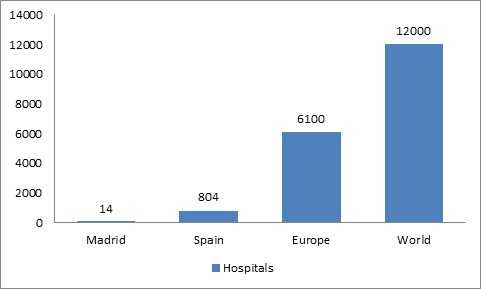
Figure 2: Trauma & Critical Care Associated Hospitals
Major Trauma & Critical Care Associations around the Globe
- American college of Surgeons Committee on Trauma
- International association for trauma surgery and intensive care (IATSIC)
- American Trauma Society
- Trauma Association of Canada (TAC)
- Western Trauma Association (WTA)
- Eastern Association for Surgery of Trauma
- American Association of Orthopaedic Surgeons
- Society of Trauma Nurses
- The United States Army Institute of Surgical research
Major Trauma & Critical Care Associations in Europe
- German society society for trauma surgery (Gsts)
- European Society for Traumatic studies (ESTSS)
- European Society for Trauma & Emergency Surgery (ESTES)
- European Society of Intensive Care Medicine (ESICM)
- Turkish Society for Trauma and Emergency surgery
Universities in Spain:
There are 11 universities, in which 4 were top ranked in Madrid and 81 universities in Spain and more than 22130 universities globally having Trauma & Critical Care study.
- University of Barcelona
- Universidad Autónoma de Madrid
- University Complutense Madrid
- University of Navarra
- Universitat Pompeu Fabra
- Autonomous University of Madrid
- Pablo de Olavide University
- Francisco de Vitoria University
University Statistics
Figure 3: Top Universities in Spain
Growth of research and Sales:
Statistics which shows Market growth in importance of research
Spain has the thirteenth-largest economy by nominal GDP in the world and sixteenth-largest by purchasing power parity. It is the fifth-largest in the European Union, and the fourth-largest in the Eurozone, based on nominal GDP statistics.
Spain is listed 23rd in UN Human Development Index and 30th in GDP per capita by World Bank, thus it is classified as high income economy and among the countries of very high human development. Between 2008 and 2012, the economic boom of the 2000s was reversed. Retail trade sales in Spain showed a gradual decline between 2008 and 2013.
During the economic downturn, Spain has been significantly reducing imports; increasing exports. In 2013 it achieved a trade surplus for the first time in three decades. In their global forecast report from 2014-2016 there was a gradual increase ranging from 0.9% to 2.05%. Spain has gradually become a net contributor of funds for less developed countries of the Union as opposed to receiving funds.
When compared to the world the sales percentage was not constant but in 2008 it showed 1.9%, in 2009 it showed a negative growth and from 2011-2016 the growth rate was increasing and decreasing. Spain has gradually become a net contributor of funds for less developed countries of the Union as opposed to receiving funds.
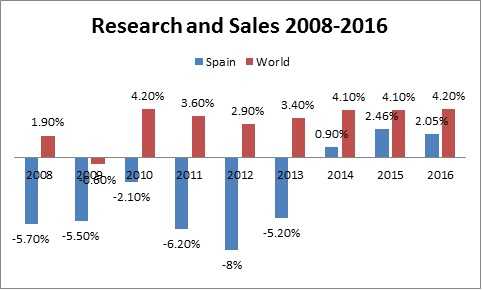
Figure 4: Investment and profit on research and sales
The top five EU nations: the UK, Spain, France, Germany, and Italy accounted for around 60% of the European retail sales through the channel in 2011 and by 2016 it is expected to decline their combined sale between 30-50% and to be overtaken by Russia, which is expected to account for around 30% of total regional sales. Japan and China together account for over two-thirds of total Asia Pacific retail accounting to 5 through 2011. Together, they are expected to share more than three-quarters of the regional online sales by 2016.
Online Retailers in North America accounted for over 40% of the Global sales which include Canada in 2011 and by 2016 its market growth remained same. European Global Online retailers Sales. Asia-Pacific that include Japan and China together account for over two-thirds of total Asia Pacific retail sales making 5% in 2011. Together, they are expected to share more than three-quarters of the regional online sales by 2016.
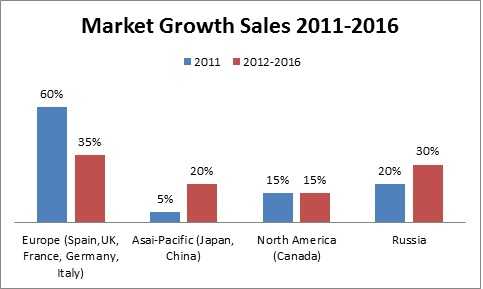
Figure 5: Share of Global market
Statistics of Doctors, Researchers and Academicians working on Trauma
According to the Statistical analysis the number of Professionals working on Trauma research is: There are 800 Doctors working at Madrid, 1773 at Spain and 4250 worldwide.
Researchers at Madrid- 250, Spain-600 and in World-1070 and Academicians at Madrid-390, Spain-810 and Worldwide-1298.

Figure 6. Trauma Doctors-Researchers-Academicians
References:
- http://www.trauma.org/archive/webpointers.
- http://en.wikipedia.org/wiki/List_of_hospitals_in_Spain
- http://www.topmastersinhealthcare.com/30-most-technologically-advanced-hospitals-in-the-world
- http://hospitals.webometrics.info/en/Europe?page=63
- http://www.topuniversities.com/where-to-study/region/europe/top-universities-europe
- http://www.temple.edu/medicine/departments_centers/clinical_departments/surgery_trauma_critical_care.hthttp://medschool.umaryland.edu/trauma/faculty.asp
- http://www.mayoclinic.org/diseases-conditions/post-traumatic-stress-disorder/basics/symptoms/con-20022540
- http://www.statista.com/statistics/263610/gross-domestic-product-gdp-growth-in-spain/
- http://www.statista.com/statistics/258568/forecast-for-global-retail-sales-growth-by-region/
- http://www.marketwired.com/press-release/market-research-forecasts-online-retail-sales-growth-at-15-cagr-through-2016-1676044.htm
- http://www.nationaltraumainstitute.org/
- https://www.facs.org/search/find-a-surgeon
- http://www.aast.org/acs-committee-members
- http://www.aast.org/Research/CommitteeMembers.aspx
- https://www.facs.org/international/countries
- http://www.elmundo.es/grafico/salud/2014/12/05/5481f563268e3efb708b4598.html
- http://www.gmc-uk.org/doctors/register/search_stats.asp
- http://surgery.ucsd.edu/divisions/trauma-burn/faculty/Pages/default.aspx
- https://www.google.co.in/webhp?sourceid=chrome-instant&ion=1&espv=2&ie=UTF-8#q=list+of+trauma+professors+in+world
Conference Highlights
- Elderly Trauma and Critical Care
- Paediatric Trauma
- Obstetric Trauma
- Critical Care in Trauma
- Psychological Trauma
- Blunt Trauma
- Intensive Care in Trauma
- Evolution in Emergency Medicine Practices
- New Technology in Trauma Care
- Trauma Emergency Medicine
- Biological Need of Trauma
- Trauma-An International Perspective
- Trauma-Mass Casualties Incident
- Trauma Therapy
- Trauma in Nursing & Midwifery
To share your views and research, please click here to register for the Conference.
To Collaborate Scientific Professionals around the World
| Conference Date | March 07-09, 2016 | ||
| Sponsors & Exhibitors |
|
||
| Speaker Opportunity Closed | Day 1 | Day 2 | Day 3 |
| Poster Opportunity Closed | Click Here to View | ||
Useful Links
Special Issues
All accepted abstracts will be published in respective Our International Journals.
- Emergency Medicine: Open Aceess
- International Journal of Emergency Mental Health and Human Resilience
- Trauma and Treatment
Abstracts will be provided with Digital Object Identifier by








